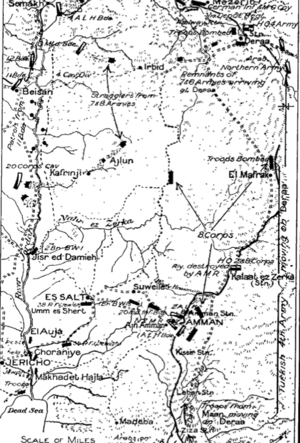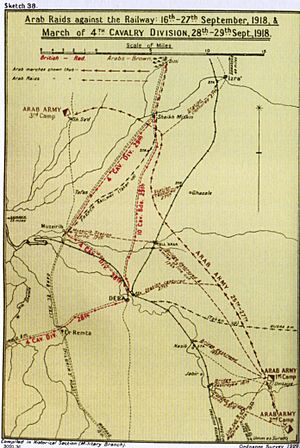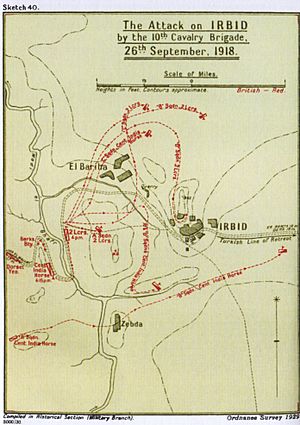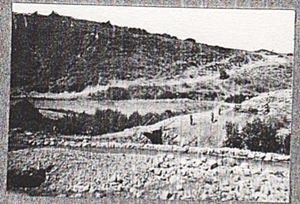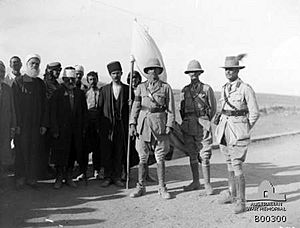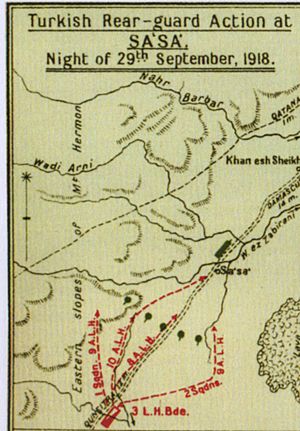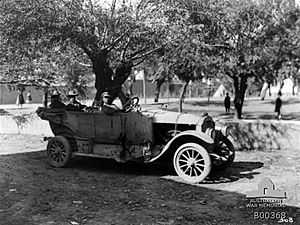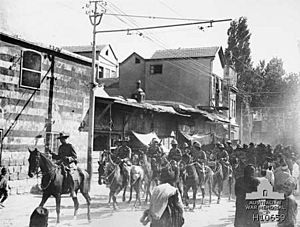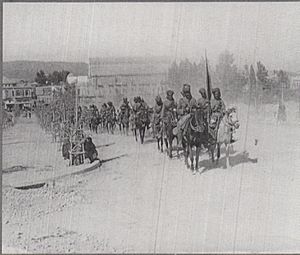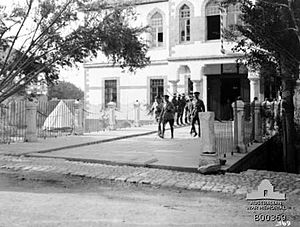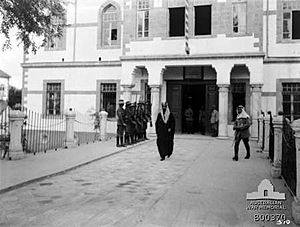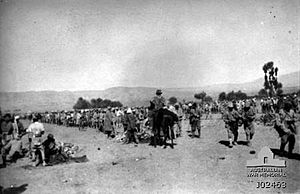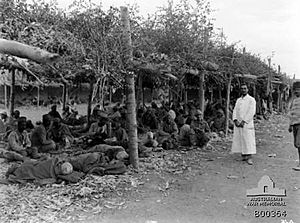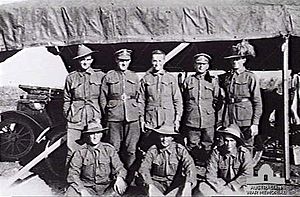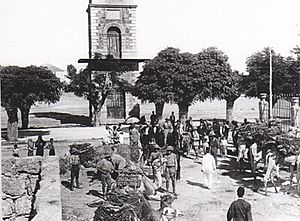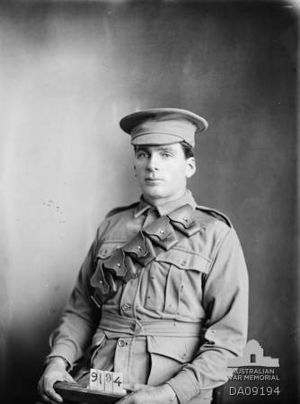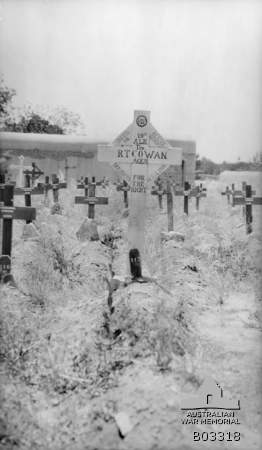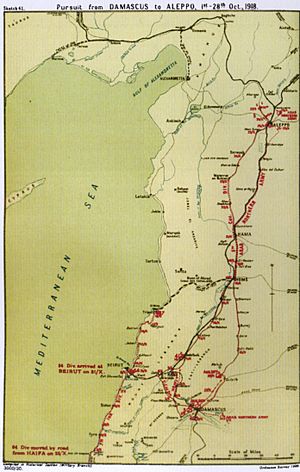Capture of Damascus facts for kids
Quick facts for kids Capture of Damascus |
|||||||
|---|---|---|---|---|---|---|---|
| Part of the Middle Eastern theatre of World War I | |||||||
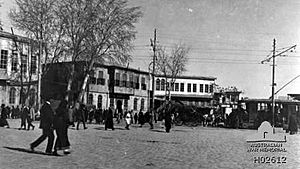 A busy city square in Damascus 1918 |
|||||||
|
|||||||
| Belligerents | |||||||
|
|
|||||||
| Commanders and leaders | |||||||
| Units involved | |||||||
| XXI Corps Desert Mounted Corps Prince Faisal's Arabian Sherifial Force |
Remnants of the Fourth Army Seventh Army Eighth Army Asia Corps |
||||||
The Capture of Damascus happened on October 1, 1918, during World War I. This important event took place after a big victory by the Egyptian Expeditionary Force (a group of British-led forces) at the Battle of Megiddo. This win opened the way for the Allied forces to chase the Ottoman army north towards Damascus.
The city was surrounded and captured by the Desert Mounted Corps (a large group of cavalry soldiers) and Prince Feisal's Arab forces. They chased the retreating Ottoman armies along the main roads to Damascus. Many smaller groups of Ottoman soldiers were captured during this chase. Taking Damascus was a huge success, but it also led to some disagreements between France, Britain, and Prince Feisal about who would control the city.
After winning battles like the Battle of Sharon and Battle of Nablus on September 25, the British-led forces achieved all their goals. The Ottoman armies were forced to retreat, and many soldiers were captured. General Edmund Allenby, the commander of the British-led forces, ordered his cavalry to chase the remaining Ottoman armies and capture Damascus.
The chase began on September 26. Arab forces captured Deraa on September 27. Australian cavalry attacked Ottoman groups along the main road, reaching Quneitra on September 28. By September 30, the cavalry was very close to Damascus. On October 1, the 3rd Light Horse Brigade rode through Damascus to cut off the retreating Ottoman soldiers.
Contents
- The Plan to Take Damascus
- The Chase Begins
- Damascus Captured
- Approaching the City
- Ottoman Defenses and Retreat
- Surrounding Damascus
- Damascus Falls (October 1)
- 3rd Light Horse Brigade Continues the Chase
- Chauvel's March Through Damascus (October 2)
- Damascus Meeting (October 3)
- Continuing Occupation
- Supply Challenges
- Medical Situation
- State of the Horses
- Impact of Sickness on the Forces
- Aftermath
- See also
The Plan to Take Damascus

After the British-led forces broke through the Ottoman front lines, two Ottoman armies were destroyed. A third Ottoman army was in full retreat. They had lost most of their transportation and weapons.
On September 22, General Allenby told Lieutenant General Harry Chauvel, who led the Desert Mounted Corps, about his plan to advance to Damascus. Before this, important supply points like Haifa had to be captured.
Ottoman Retreat and German Commander's Orders
The German commander, Otto Liman von Sanders, retreated from Nazareth and arrived in Deraa on September 21. He ordered his Fourth Army to withdraw. He then moved to Damascus, arriving on September 23. He asked for more troops to defend Damascus, but on September 25, he ordered his staff to move even further north to Aleppo.
Between 6,000 and 7,000 German and Ottoman soldiers managed to retreat towards Damascus. On September 26, Colonel Gustav von Oppen reached Deraa with 700 men. Liman von Sanders ordered him to leave by train. Von Oppen's train was delayed, but he reached Damascus on September 28 and was ordered to continue to Rayak to set up a defensive line.
Allenby's Plans for the Advance
On September 25, General Allenby explained his plan to advance to Damascus. The first step was to reach the line between Damascus and Beirut. While one infantry division would march along the coast to Beirut, three divisions of the Desert Mounted Corps would advance on Damascus.
Major General H. J. Macandrew's 5th Cavalry Division and Major General H. W. Hodgson's Australian Mounted Division were ordered to advance about 90 miles (145 km) to Damascus. They would travel along the west side of the Sea of Galilee, across the Jordan River, through Quneitra, and then to Damascus.
Major General G. de S. Barrow's 4th Cavalry Division was ordered to ride north from Beisan. They would cross the Jordan River and advance east to Deraa, hoping to capture retreating Ottoman soldiers. If they missed them, they would chase them north along the ancient Pilgrims' Road and the Hejaz Railway to Damascus, about 140 miles (225 km) away.
The Chase Begins
Arab Forces Capture Deraa
On September 21, Prince Feisal's Arab forces were told about Allenby's successful attack. They were asked to cut off the Ottoman escape routes. Allenby told Prince Feisal that he could enter Damascus safely once his troops arrived.
The remaining Ottoman Fourth Army retreated north through Deraa. They were chased by Arab forces. Prince Feisal's 4,000-strong force marched overnight on September 26-27. They crossed the railway north of Deraa and tore up the tracks. They captured 2,000 prisoners between noon on September 26 and noon on September 27. On September 28, the 4th Cavalry Division entered Deraa and met T. E. Lawrence and Colonel Nuri Bey. They agreed that the Arab forces would protect the cavalry's right side as they chased the Ottomans north to Damascus.
4th Cavalry Division's Advance
The 4th Cavalry Division began its chase through Deraa on September 26.
Battle at Irbid (September 26)
Late on September 26, the 10th Cavalry Brigade was attacked by a strong group of Ottoman soldiers near Irbid. A mounted attack by the 2nd Lancers failed, and they suffered heavy losses.
Fighting at Ar-Ramtha (September 27)
At Ar-Ramtha, another strong Ottoman position was captured by the 10th Brigade after a tough fight. The 1/1st Dorset Yeomanry charged and captured 50 Ottoman soldiers. The Central India Horse also attacked, capturing four machine guns and 60 prisoners. The fight was over by noon.
Entering Deraa (September 28)
On September 28, the 4th Cavalry Division reached Deraa. They found that Prince Feisal's Arab forces had already captured the town the day before. A British airman who had been a prisoner was freed there.
Continuing to Dilli (September 29)
The 4th Cavalry Division continued its 70-mile (113 km) chase from Deraa to Damascus. Prince Feisal's Arab forces protected their right side. The division moved north and camped at Dilli for the night of September 29-30. They were running low on supplies but found some food and animals in the captured areas.
General Allenby reported that his forces had captured over 60,000 prisoners by September 29. He hoped his cavalry would reach Damascus the next day.
Reaching Zeraqiye (September 30)
On September 30, the 4th Cavalry Division rode towards Kiswe, about 30 miles (48 km) away. The main Ottoman army was closer to Damascus. Arab forces attacked a large Ottoman group, almost destroying it. Only one German battalion reached Damascus that day. By the evening of September 30, the 4th Cavalry Division was still 34 miles (55 km) from Damascus.
Australian and 5th Cavalry Divisions Advance
From Tiberias to Jisr Benat Yakub
The 5th Cavalry Division reached Kefr Kenna on September 26. The Australian Mounted Division arrived at Tiberias on September 26. After resting, they sent patrols towards Jisr Benat Yakub.
Battle at Jisr Benat Yakub (September 27)
On September 27, the Australian Mounted Division, followed by the 5th Cavalry Division, began their chase to Damascus. They were stopped for a few hours at Jisr Benat Yakub (Bridge of the Daughters of Jacob). The Ottoman soldiers had blown up the bridge and set up strong defenses with machine guns.
French soldiers attacked the Ottoman positions at the bridge. Other Australian soldiers swam across the river to find a way around. During the night, engineers built a new bridge, and by daylight on September 28, the Australian Mounted Division was moving towards Quneitra.
Deir es Saras (September 27-28)
The 3rd Light Horse Brigade crossed the Jordan River by midnight and advanced to Deir es Saras. They attacked and captured a strong Ottoman group there.
On September 28, Ottoman aircraft bombed Australian positions, but British planes chased them away.
Taking Quneitra (September 28)
The Ottoman forces defending the Jordan River were reinforced at Quneitra by troops from Damascus. On September 28, an air report said about 1,200 Ottoman soldiers were holding the high ground around Quneitra.
Australian cavalry encountered 20 Circassian cavalrymen who charged them. The Australian soldiers charged back with swords, killing or capturing them. The Australian Mounted Division arrived at Quneitra, followed by the 5th Cavalry Division. Both divisions camped near the village.
Quneitra was an important town about 40 miles (64 km) from Damascus. It was home to many Circassian people. General Chauvel appointed Brigadier General Grant to keep order around Quneitra and protect the supply lines.
On September 29, food was distributed to the troops. They had to take supplies from the local area to feed themselves and 400 prisoners. By September 30, the 11th Light Horse Regiment was patrolling the area around the clock.
Continuing the Advance (September 29-30)
On September 29, air reconnaissance spotted retreating German and Ottoman soldiers south of Damascus. An armored car patrol was attacked by a strong Ottoman group with machine guns and cannons south of Sa'sa.
Action at Sa'sa (September 29-30)
The advance to Damascus continued on the afternoon of September 29. The 3rd Light Horse Brigade moved first. They encountered a strong Ottoman position. The area was too rough for cavalry to advance easily at night.
At 2:00 AM on September 30, the 8th Light Horse Regiment attacked the Ottoman position. With help from other regiments, they captured the position by 3:00 AM, taking five machine guns and some German prisoners. The 10th Light Horse Regiment chased the retreating Ottomans, capturing more guns and prisoners.
Battle at Kaukab (September 30)
The 3rd and 5th Light Horse Brigades and another force were ordered to continue advancing west of Damascus to cut off escape routes. At dawn, the 4th Light Horse Brigade attacked an Ottoman group near Kaukab, capturing 350 prisoners, a cannon, and eight machine guns.
The Ottoman forces had set up a strong position on a ridge. The Australian and French cavalry charged with swords. The Ottoman defenders broke and ran. They captured 72 prisoners and 12 machine guns. From Kaukab, Damascus was only 10 miles (16 km) away.
5th Cavalry Division's Action
Battle at Kiswe (September 30)
On September 29, Mustafa Kemal Pasha, an Ottoman commander, arrived at Kiswe. Liman von Sanders ordered him to continue to Rayak, north of Damascus. By September 30, the leading Ottoman column was approaching Kiswe, about 10 miles (16 km) south of Damascus.
The 5th Cavalry Division was ordered to attack a 2,000-strong Ottoman column. Two regiments bypassed Kiswe to attack another Ottoman group closer to Damascus. They charged into the German and Ottoman forces, splitting them up and capturing 40 officers and 150 men. The 14th Brigade captured a total of 594 prisoners.
Summary of Cavalry Advances
After four days, the Australian Mounted and 5th Cavalry Divisions reached Damascus. They had fought many battles and captured over 60,000 prisoners, 140 cannons, and 500 machine guns. General Chetwode congratulated General Chauvel for his "historic ride to Damascus."
Damascus Captured
Approaching the City
Damascus is surrounded by a large green plain, which looks very different from the dry, rocky land around it. The city itself is hidden in a forest. You don't see its towers until you are very close.
In 1918, Damascus was the largest city in Syria. It was a diverse city with Arab, Christian, and Jewish people. The people were very independent and didn't like outside control.
Ottoman Defenses and Retreat
Liman von Sanders ordered some Ottoman divisions to defend Damascus, but he realized he couldn't hold the city. He moved his headquarters north to Aleppo. On September 30, many retreating Ottoman units passed through Damascus. The 146th Regiment was the last to leave the city that day.
Surrounding Damascus
Australian aircraft had seen hundreds of trains and retreating soldiers around Damascus since September 27. By September 28, the Damascus airfield was bombed and burned. The city was being evacuated.
By midnight on September 30, the Australian Mounted Division was west of the city, the 5th Cavalry Division was south, and the 4th Cavalry Division was further south. General Chauvel ordered the 5th Cavalry Division to the east of Damascus and the Australian Mounted Division to the west to block escape routes and occupy the city.
Damascus Falls (October 1)
The independence of Syria was declared, and the Hejaz flag was raised over the Governor's palace by Emir Said Abd el Kader. He formed a temporary council to rule the city. British orders were to let Prince Feisal's forces enter the city first, even though the British-led forces had reached it earlier. The 3rd Light Horse Brigade had camped outside the city and set up guards to control who entered.
At 5:00 AM on October 1, 1918, the 3rd Light Horse Brigade entered Damascus. They captured hundreds of Ottoman soldiers at the Dummar Station and the Baramkie railway station. As they rode through the city, they passed thousands of Ottoman soldiers who did not fight them.
At the Town Hall, Major Arthur Charles Olden of the 10th Light Horse Regiment accepted the surrender of the city from Emir Said Abd el Kader. Damascus was in chaos, with no proper government or military control. Olden asked for a guide to help his soldiers through the city to the Homs road.
New Government and Disagreements
Syrian independence was declared, even though about 15,000 Ottoman and German soldiers were still in Damascus. General Allenby reported to King Hussein, Prince Feisal's father, that they had entered the city and captured over 7,000 prisoners. The Arab Army arrived in Damascus at 7:30 AM. They declared their loyalty to King Hussein and set up an Arab governor.
This Arab action complicated things because France also had claims in the area. This caused the French to distrust Prince Feisal. Shukri Pasha was later appointed Military Governor of Damascus.
Allenby reported that the Australian Mounted Division and the Arab Army had occupied Damascus. He said the local government would remain in charge, and most troops would be withdrawn from the city. He planned to visit Damascus himself.
Occupation and Prisoners
At 6:40 AM on October 1, the Australian Mounted Division ordered patrols around Damascus. A barracks with 265 officers and 10,481 men surrendered to the 4th Light Horse Regiment. These prisoners were marched to a camp outside the city. Guards were placed on public buildings until Arab troops took over.
The Desert Mounted Corps had captured a total of 47,000 prisoners since September 19. Between September 26 and October 1, they captured 662 officers and 19,205 other soldiers. About 20,000 sick, tired, and disorganized Ottoman troops were captured in and around Damascus. The 4th Light Horse Brigade alone captured 11,569 prisoners in the city.
General Allenby estimated that 40,000 Ottoman soldiers were retreating towards Damascus on September 26. His cavalry had captured half of them. This victory was so big that it basically ended the campaign.
3rd Light Horse Brigade Continues the Chase
After taking Damascus, the 3rd Light Horse Brigade moved north along the Homs road. They fought several small but tough battles on October 1, capturing 750 prisoners and many machine guns.
The next day, October 2, a long column of Ottoman soldiers was trying to escape north. The 9th Light Horse Regiment quickly caught up to them. They cut off the road, and the column surrendered. They captured over 2,000 prisoners, including a divisional commander and the flag of the 146th Regiment. This was the only Ottoman flag captured by Australians in World War I.
Chauvel's March Through Damascus (October 2)
When General Chauvel arrived in Damascus, he learned that the Arab forces wanted to make it seem like they had driven out the Ottomans. To show British strength, Chauvel decided to march his troops through the city the next day.
Detachments from each brigade of the Desert Mounted Corps, along with cannons and armored cars, marched through Damascus. This included Australian light horse, French cavalry, British soldiers, and Indian cavalry.
The march began at 12:30 PM and finished at 3:00 PM.
Damascus Meeting (October 3)
British leaders had been discussing who would control Syria after the war. Britain wanted Prince Feisal to rule Syria from Damascus.
General Allenby met with Prince Feisal in Damascus on October 3. Allenby told Prince Feisal to "moderate his aims" and wait for decisions from London. He explained that he would control Syria, but France would control Lebanon. Allenby made it clear that he was in charge as long as military operations were happening.
Prince Feisal claimed that Lawrence had promised him that Arabs would control all of Syria, including access to the Mediterranean Sea. He said he knew nothing about France's claim to Lebanon. Allenby left for Tiberias shortly after.
German Government Resigns
The German government resigned on October 3, as their armies were retreating after many defeats.
Continuing Occupation
The 12th Light Horse Regiment camped north-east of Kafarsouseh from October 1. They took over guard duties from the 5th Cavalry Division on October 4. On October 7, a German plane dropped bombs near their headquarters, but no one was hurt. They continued various guard duties in Damascus.
Allenby reported that the total number of prisoners captured by his forces was over 75,000. He estimated that only about 17,000 Ottoman soldiers had escaped, and only 4,000 of those could still fight. He also noted that Damascus was peaceful, and food prices had dropped.
Kaukab Prisoner of War Camp
At Kaukab, 10,000 prisoners were joined by 7,000 more. They were in terrible condition, and many died each day. Lieutenant Colonel T. J. Todd of the 10th Light Horse Regiment took over guarding them. He found that food was poor, and there were no medicines or bandages for the sick and wounded.
Todd organized the prisoners, got blankets, and found Syrian doctors to treat the sick. He also got mobile kitchens to cook soup. By October 18, prisoners began to be moved out of the camp.
Supply Challenges
Damascus was 150 miles (241 km) from the British-led forces' main bases, and Aleppo was even further. This made it very hard to get food and medical supplies to the troops.
Captured ports like Haifa were quickly used as supply bases. Supplies began arriving at Haifa on September 27. However, moving supplies from Haifa to Damascus was difficult because of damaged railways and bad roads. A 2-mile (3.2 km) stretch of road from Jisr Benat Yakub to Quneitra was especially bad. It took three days for motor lorries to travel the 90 miles (145 km) from Semakh to Damascus.
On October 4, a supply convoy broke down, leaving some soldiers without meals. By October 19, supplies of tea, milk, and sugar were brought to Beirut and then by lorries to Damascus.
Taking Local Supplies
The Desert Mounted Corps, with nearly 20,000 men and horses, relied heavily on local supplies from September 25 onwards. They had to take food and other items from the local area. This was done carefully, without taking essential food from the people.
Medical Situation
At first, no medical units could enter Damascus because of the chaos. They started arriving the next day. Many of the 3,000 sick and wounded Ottoman soldiers were found in various hospitals. Caring for them was the first priority for the medical service.
While there was no cholera in Damascus, many prisoners had typhus, malaria, and influenza. British-led forces' field ambulances treated over 2,000 cases. Moving seriously ill patients from Damascus to Haifa, a 140-mile (225 km) journey, was very difficult. It involved motor lorries and trains, and the journey was so tiring that it had to be done in two stages.
The supply of motor lorries was not enough to move both the sick and wounded and the prisoners. Over 10,000 prisoners in Damascus put a lot of pressure on the food supply.
Spanish Flu and Malaria
During the chase, the Desert Mounted Corps had traveled through areas with malaria. Within a few days of the fighting ending in Damascus, malaria and pneumonic influenza (a type of flu) spread quickly through the regiments. The epidemic grew very fast, especially in Damascus. Many soldiers became seriously ill. Medical supplies, food, blankets, and mattresses quickly ran short.
The Australian Medical Corps was in charge of caring for the sick in Damascus. Many cases that were thought to be other diseases were actually malaria. The number of sick soldiers doubled from September 1 to October 1. Many who had suffered from malaria before became sick again.
Medical staff also became ill at a higher rate than combat soldiers. Many doctors became sick, making the situation even harder. By October 14, the situation in Damascus was improving.
The 12th Light Horse Regiment was hit hard by fever. By October 17, they were short of one officer and 144 soldiers. However, by October 19, the situation began to improve.
State of the Horses
Horses that had been in the field for a long time survived the marches well. However, those that had recently arrived did not do as well. During the Battle of Megiddo and Capture of Damascus, from September 15 to October 5, 1,021 horses were killed or died. Many more were treated for injuries and illnesses.
Impact of Sickness on the Forces
The number of sick soldiers due to malaria doubled from September 1 to October 1. For the week ending October 12, the Desert Mounted Corps had 3,109 sick soldiers. Although the death rate was not high, four times as many deaths occurred in Damascus hospitals as were killed in battle between September 19 and October 1.
Aftermath
The capture of Damascus was such a big victory that it meant there would likely be no more major battles in the region. The Allies believed the Ottoman Empire's resources were almost gone.
The 7th (Meerut) Division advanced along the coast, capturing Beirut on October 7 and Tripoli on October 13. These ports became important for supplying the forces moving inland. The 5th Cavalry Division reached Baalbek on October 10 and Homs on October 13. They were then ordered to advance to Aleppo, 120 miles (193 km) away.
Aleppo was captured by Prince Feisal's Arab army with support from armored cars on October 25. A cemetery for British and Commonwealth soldiers from World War I and World War II is located near Mezzeh.
See also
 In Spanish: Batalla de Damasco para niños
In Spanish: Batalla de Damasco para niños


